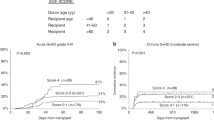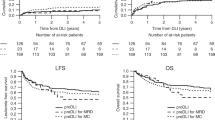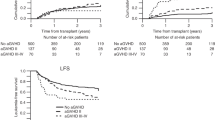Summary:
In the present study, we analyze factors predicting graft-versus-host disease (GvHD) and response after donor lymphocyte infusions (DLI). A total of 100 patients received 593 DLI between June 1990 and December 2000 in a bulk dose (n=14) or in escalating dose infusions (n=86). Patients were analyzed after stratification for type of relapse: (1) molecular relapse (n=6), (2) cytogenetic relapse (n=20), (3) chronic phase of chronic myeloid leukemia (CML) or complete remission of other disease post chemotherapy (n=24), (4) CML in accele-rated/blastic phase (n=14), (5) resistant disease not responding to chemotherapy (n=36). The proportion of responders to DLI in these five groups was 100, 90, 75, 36 and 0% (P<0.0001). Factors predicting response by multivariate analysis were type of relapse (P<0.0001), post-DLI GvHD (P=0.005), pancytopenia (P=0.008), and a diagnosis of CML (P=0.04). Acute GvHD (grades II—IV) occurred in 21 patients (21%), and correlated in multivariate analysis with pancytopenia and less than four DLI. Other predictors of GvHD were the number of CD3+cells/infusion and serum levels of gamma-glutamyl transferase (γGT). The actuarial probability of treatment-related mortality was 9% for HLA identical siblings and 44% for alternative donor transplants (P=0.006). Response to DLI is predicted by tumor burden and is associated with GvHD and pancytopenia.
This is a preview of subscription content, access via your institution
Access options
Subscribe to this journal
Receive 12 print issues and online access
$259.00 per year
only $21.58 per issue
Buy this article
- Purchase on Springer Link
- Instant access to full article PDF
Prices may be subject to local taxes which are calculated during checkout






Similar content being viewed by others
References
Goldman JM, Gale RP, Horowitz MM et al. Bone marrow transplantation for the treatment of chronic myelogenous leukemia in chronic phase. Ann Intern Med 1988; 108: 806–814.
Reiter E, Greinix HT, Brugger S et al. Long term follow up after allogeneic stem cell transplantation for chronic myelogenous leukemia. Bone Marrow Transplant 1998; 22: S86–S88.
Gorin NC, Labopin M, Fouillard L et al. Retrospective evaluation of autologous bone marrow transplantation vs allogeneic bone marrow transplantation from an HLA identical related donor in acute myelocytic leukemia. A study of the European Cooperative Group for Blood and Marrow Transplantation (EBMT). Bone Marrow Transplant 1996; 18: 111–117.
Weiden PL, Flournoy N, Thomas ED et al. Antileukemic effect of graft versus host disease in human recipient of allogeneic marrow grafts. N Engl J Med 1979; 300: 1068–1073.
Marmont AM, Horowitz MM, Gale RP et al. T-cell depletion of HLA-identical transplants in leukemia. Blood 1991; 78: 2120–2130.
Locatelli F, Zecca M, Rondelli et al. Graft versus host disease prophylaxis with low dose cyclosporine reduces the risk of relapse in children with acute leukemia given HLA identical sibling bone marrow transplantation: results of a randomized trial. Blood 2000; 95: 1572–1579.
Zikos P, van Lint MT, Lamparelli T et al. Allogeneic hemopoietic stem cell transplantation for patients with high risk acute lymphoblastic leukemia: favorable impact of chronic graft-versus-host disease on survival and relapse. Haematologica 1998; 83: 896–903.
Kolb HJ, Schattenberg A, Goldman JM et al. Graft versus leukemia effect of donor lymphocyte transfusions in marrow grafted patients. Blood 1995; 86: 2041–2050.
Kolb HJ . Relapse. The EBMT Handbook. Blood Marrow Transplant 2000; 1: 200–215.
Collins RH, Shpilberg O, Drobyski WR et al. Donor leukocyte infusions in 140 patients with relapsed malignancy after allogeneic bone marrow transplantation. J Clin Oncol 1997; 15: 433–444.
Porter DL, Collins RH, Shpilberg O et al. Long term follow up of patients who achieved complete remission after donor leukocyte infusion. Biol Blood Marrow Transplant 1999; 5: 253–261.
Slavin S, Naparstek E, Nagler A et al. Allogeneic cell therapy for relapsed leukemia after bone marrow transplantation with donor peripheral blood lymphocytes. Exp Hematol 1995; 23: 1553–1562.
Frassoni F, Podestà M, Piaggio G et al. Relapse after allogeneic BMT for chronic myeloid leukemia (CML) may be sustained by a small number of leukemic ‘stem cells’: a hypothesis. Bone Marrow Transplant 1999; 24: 689–691.
Champlin R, Khouri I, Kornablau S et al. Allogeneic hematopoietic transplantation as adoptive immunotherapy. Hematopoietic Stem Cell Ther 1999; 13: 1041–1057.
Dazzi F, Szylo RM, Goldman JM . Donor lymphocyte infusions for relapse of chronic myeloid leukemia after allogeneic stem cell transplant: where we now stand. Exp Hematol 1999; 27: 1477–1486.
Mackinnon S, Papadopulos EB, Carabasi MH et al. Adoptive immunotherapy evaluating escalating doses of donor leukocytes for relapse of chronic myeloid leukemia after bone marrow transplantation: separation of graft versus leukemia responses from graft versus host disease. Blood 1994; 86: 1261–1268.
Dazzi F, Szydlo RM, Craddock C et al. Comparison of single dose and escalating dose regimens of donor lymphocyte infusion for relapse after allografting for chronic myeloid leukemia. Blood 2000; 95: 67–71.
Keil F, Haas OA, Fritsch G et al. Donor leukocyte infusion for leukemic relapse after allogeneic marrow transplantation: lack of residual donor hematopoiesis predicts aplasia. Blood 1997; 89: 3113–3117.
Carlens S, Remberger M, Aschan J et al. The role of disease stage in the response to donor lymphocyte infusions as treatment for leukemic relapse. Biol Blood Marrow Transplant 2000; 7: 31–38.
Schafer H, Bader P, Kaiserling E et al. Extramedullary relapses at uncommon sites after allogeneic stem cell transplantation. Bone Marrow Transplant 2000; 26: 1133–1134.
Au WY, Lie AKW, Liang R et al. Isolated extramedullary relapse of acute lymphoblastic leukemia after allogeneic bone marrow transplantation. Bone Marrow Transplant 1999; 24: 1137–1140.
Goldberg SL, Mangan KF, Klumpp TR et al. Lack of graft versus leukemia effect in an immunologically privileged site (letter). Bone Marrow Transplant 1994; 14: 180–181.
Seo S, Kami M, Honda H et al. Extramedullary relapse in the so-called ‘sanctuary’ sites for chemotherapy after donor lymphocyte infusion (letter). Bone Marrow Transplant 2000; 25: 226–227.
Lokhorst HM, Schattenberg A, Cornelissen JJ et al. Donor lymphocyte infusions for relapsed multiple myeloma after allogenic stem-cell transplantation: predictive factors for response and long-term outcome. J Clin Oncol 2000; 18: 3031–3037.
Orsini E, Aleya EP, Chillemi A et al. Conversion to full donor chimerism following donor lymphocyte infusion is associated with disease response in patients with multiple myeloma. Biol Blood Marrow Transplant 2000; 6: 375–386.
Sprent J, Surh CD, Agus D et al. Profound atrophy of the bone marrow reflecting major histocompatibility complex class II-restricted destruction of stem cells by CD4+cells. J Exp Med 1994; 180: 307–317.
Dominietto A, Raiola AM, van Lint Mt et al. Factors influencing hematologic recovery after allogeneic hemopoietic stem cells transplant (HSCT): graft versus host disease, donor type, cytomegalovirus infections and cell dose. Br J Haematol 2000; 112: 219–227.
Glucksberg H, Storb R, Fefer A et al. Clinical manifestations of graft versus host disease in human recipients of marrow from HL-A-matched sibling donors. Transplantation 1974; 18:295–304.
Sullivan K, Weiden P, Storb R et al. Influence of acute and chronic graft-versus-host disease on relapse and survival after bone marrow transplantation from HLA-identical siblings as treatment of acute and chronic leukaemia. Blood 1989; 73: 1720–1728.
Mattei D, Saglio G, Gottardi E et al. Persisting molecular remission ten years after donor lymphocyte infusion for hematologic relapse in chronic myeloid leukemia. Haematologica 2001; 86: 545–546.
Alyea EP, Soiffer RJ, Canning C et al. Toxicity and efficacy of defined doses of CD4+donor lymphocytes for treatment of relapse after allogeneic bone marrow transplant. Blood 1998; 91: 3671–3680.
Bacigalupo A, Soracco M, Vassallo F et al. Donor lymphocyte infusions in patients with chronic myeloid leukemia following allogeneic bone marrow transplantation. Bone Marrow Transplant 1997; 19: 927–932.
Acknowledgements
This work was supported by Associazione Italiana Ricerca contro il Cancro (AIRC) Milano grant to AB and Associazione Ricerca Trapianto Midollo Osseo (ARITMO) Genova. The great work of our nursing staff is gratefully acknowledged.
Author information
Authors and Affiliations
Rights and permissions
About this article
Cite this article
Raiola, A., Van Lint, M., Valbonesi, M. et al. Factors predicting response and graft-versus-host disease after donor lymphocyte infusions: a study on 593 infusions. Bone Marrow Transplant 31, 687–693 (2003). https://doi.org/10.1038/sj.bmt.1703883
Received:
Accepted:
Published:
Issue Date:
DOI: https://doi.org/10.1038/sj.bmt.1703883
Keywords
This article is cited by
-
Chemotherapy plus DLI for relapse after haploidentical HSCT: the biological characteristics of relapse influences clinical outcomes of acute leukemia patients
Bone Marrow Transplantation (2019)
-
CTLA4-CD28 chimera gene modification of T cells enhances the therapeutic efficacy of donor lymphocyte infusion for hematological malignancy
Experimental & Molecular Medicine (2017)
-
Minimal residual disease- and graft-vs.-host disease-guided multiple consolidation chemotherapy and donor lymphocyte infusion prevent second acute leukemia relapse after allotransplant
Journal of Hematology & Oncology (2016)
-
DLI after haploidentical BMT with post-transplant CY
Bone Marrow Transplantation (2015)
-
Donor lymphocyte infusions for the treatment of chronic myeloid leukemia relapse following peripheral blood or bone marrow stem cell transplantation
Bone Marrow Transplantation (2013)



